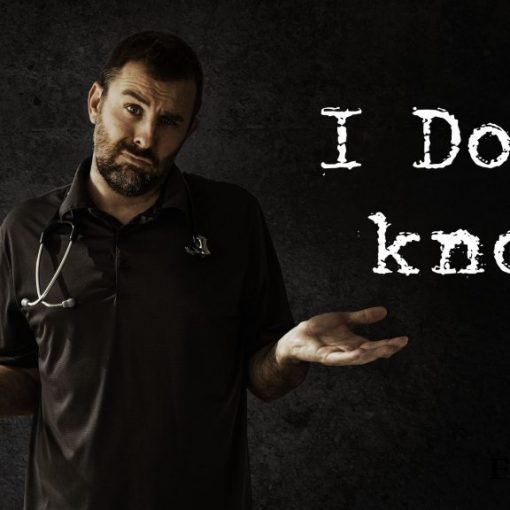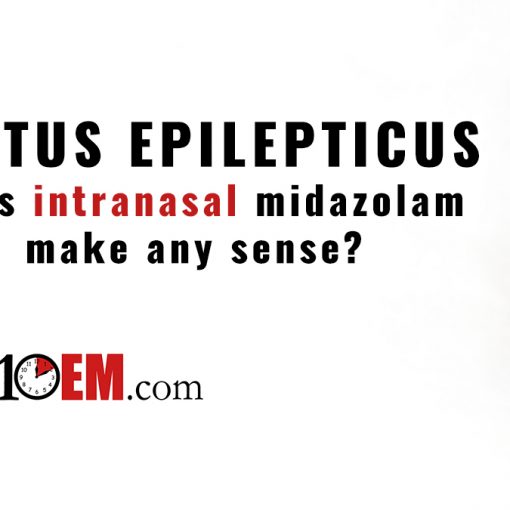A 50 year old woman presents with a 2 day history of dysuria, for which she was started on ciprofloxacin last night. Since this morning, she has become increasingly weak, and now finds it impossible to get out of bed. She called 911 when she noticed she couldn’t catch her breath. She wonders whether this might be related to her myasthenia gravis…
Introduction
Myasthenic crisis is a clinical diagnosis defined by respiratory failure in a patient with myasthenia gravis. (Ahmed 2005; Roper 2017) It will occur in approximately 15-20% of patients with myasthenia gravis. (Ahmed 2005; Spillane 2012) The diagnosis is based on a clinical assessment of the respiratory status, sometimes supplemented with pulmonary function tests. (Ahmed 2005) For more information about myasthenia gravis, see this rapid review.
My approach
Make the diagnosis
Perform a thorough respiratory assessment on all patients with myasthenia gravis presenting to the emergency department. Subjective air hunger, rapid respiratory rate, and accessory muscle use are all signs of impending respiratory failure. A rapid bedside test is to ask the patient to count as long as they can on a single breath. Normally, one should be able to count easily to 30. Patients who are unable to get to 20 are likely to have significant impairment of their respiratory muscles. (Ahmed 2005; Roper 2017) Finally, pulmonary function testing can be helpful, with a forced vital capacity less than 15-20 mL/kg representing severe disease and probable need for intubation. (Ahmed 2005) (The value of PFTs in myasthenia gravis may not be evidence based.)

Cholinergic crisis (an acute or chronic overdose of anticholinesterase medication) can present very similarly. However, changes in the management of myasthenia gravis have made cholinergic crisis very rare, and the initial emergency department management does not differ from myasthenic crisis, so the distinction is probably unimportant. (Ahmed 2005, Roper 2017)
Ventilatory support
Noninvasive positive pressure ventilation is a good option for patients with appropriate mentation, and who are able to manage their secretions. (Rabinstein 2002; Seneviratne 2008) High flow, humidified nasal cannula is another option, although one lacking evidence at this time, and therefore should probably be reserved for patients with contraindications to, or unable to tolerate, BiPAP.
Intubation
There is no clear evidence based recommendation on when to intubate in myasthenic crisis. Expert consensus seems to suggest liberal intubation, but most patients probably warrant a trial of noninvasive ventilation first. (Ahmed 2005; Flower 2012; Roper 2017)
The major question is whether or not to use a paralytic. Succinylcholine works by activating acetylcholine receptors and preventing repolarization. However, there were will many fewer of these receptors, so larger doses would be required, the response is unpredictable, and a prolonged effect should be expected. (Roper 2017) Most sources suggest avoiding succinylcholine. On the other hand, rocuronium is a non-depolarizing agent that competes with acetylcholine at the receptor site. As these sites are occupied by antibodies in myasthenia gravis, a lower dose than usual is required (0.5mg/kg). (Flower 2012)
It has been argued that a sedative only intubation is the ideal in myasthenic crisis, because of the prolonged effect of paralytics. (Narimastu 2003; Vlajkovic 2009) Personally, I would still perform a standard RSI, using rocuronium at a lower dose, because I still want the highest chance at first pass success, and most of these patients will remain intubated for a long time either way. (Roper 2017)
Unless a respiratory illness was the precipitant, ventilation and oxygenation should not be difficult. Standard vent settings with a low FiO2 should suffice. For example, I would start with a tidal volume of 8mL/kg ideal body weight, a respiratory rate of 16, a PEEP of 5, and an Fi02 of 40% (with a target oxygen saturation of 90-96%). (Wendell 2011)
Find the cause
Search for and treat any precipitating event. Almost any stressor can precipitate myasthenic crisis. (Roper 2017) Infections are the most common cause, so cultures and empiric antibiotics are probably warranted while other investigations are underway. It is also important to carefully review the patient’s medication list, as there are a number of medications that can precipitate myasthenic crisis.
Manage exacerbating factors
There are a number of factors that can exacerbate weakness. Hypokalemia, hypomagnesemia, and hypophosphatemia should all be treated, if present. Anemia will also worsen weakness, so transfusion to a slightly higher target than normal might be warranted. (Ahmed 2005)
Consult for specific therapy
Emergency department management of myasthenia crisis should focus on supportive care and identification and treatment of the underlying cause. Specific treatment may involve plasma exchange, IVIG, and immunosuppressive drugs, but none of these therapies are immediately life saving, and can safely be deferred until consultation with a neurologist. (Ahmed 2005) Acetylcholinesterase inhibitors are generally held in the acute stage, as they can worsen pulmonary secretions, and could be causing weakness if the diagnosis is actually cholinergic crisis. (Wendell 2011)
Notes
The median duration of hospitalization in myasthenic crisis is 1 month, with approximately half that time spent in the ICU. However, outcomes are generally excellent, with patients expected to return to fully productive lives after recovery. (Ahmed 2005)
Other FOAMed Resources
The Internet Book of Critical Care: Myasthenia gravis & myasthenic crisis
PulmCrit: Five pearls for the dyspneic patient with Guillain-Barre Syndrome or Myasthenia Gravis
References
Ahmed S, Kirmani JF, Janjua N, et al. An Update on Myasthenic Crisis. Current treatment options in neurology. 2005; 7(2):129-141. PMID: 15676116
Flower O, Bowles C, Wijdicks E, Weingart SD, Smith WS. Emergency neurological life support: acute non-traumatic weakness. Neurocritical care. 2012; 17 Suppl 1:S79-95. PMID: 22972018
Narimatsu E, Munemura Y, Kawamata M, Imaizumi H, Namiki A, Iwasaki H. Tracheal intubation without neuromuscular relaxants for thymectomy in myasthenic patients. Journal of medicine. 2003; 34(1-6):47-58. PMID: 17682311
Rabinstein A, Wijdicks EF. BiPAP in acute respiratory failure due to myasthenic crisis may prevent intubation Neurology. 2002; 59(10):1647-1649.
Roper J, Fleming ME, Long B, Koyfman A. Myasthenia Gravis and Crisis: Evaluation and Management in the Emergency Department. The Journal of emergency medicine. 2017; 53(6):843-853. [28916122]
Seneviratne J, Mandrekar J, Wijdicks EF, Rabinstein AA. Noninvasive ventilation in myasthenic crisis. Archives of neurology. 2008; 65(1):54-8. PMID: 18195139
Spillane J, Higham E, Kullmann DM. Myasthenia gravis. BMJ (Clinical research ed.). 2012; 345:e8497. PMID: 23261848
Vlajković G, Sindelić R, Marković D, Terzić M, Bumbasirević V. [Endotracheal intubation without the use of muscle relaxants in patients with myasthenia gravis]. Medicinski pregled. ; 62(9-10):412-6. PMID: 20391735
Wendell LC, Levine JM. Myasthenic crisis. The Neurohospitalist. 2011; 1(1):16-22. PMID: 23983833
Morgenstern, J. Myasthenic crisis, First10EM,
December 3, 2018. Available at:
https://doi.org/10.51684/FIRS.6425






3 thoughts on “Myasthenic crisis”